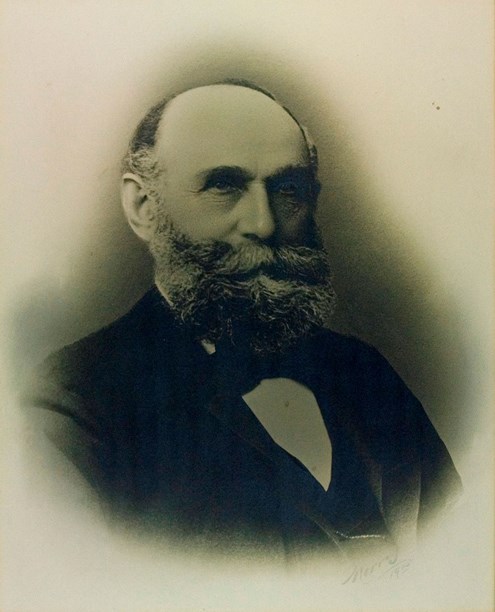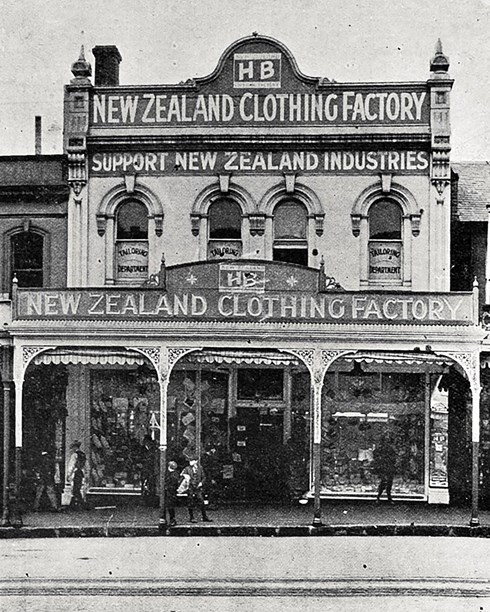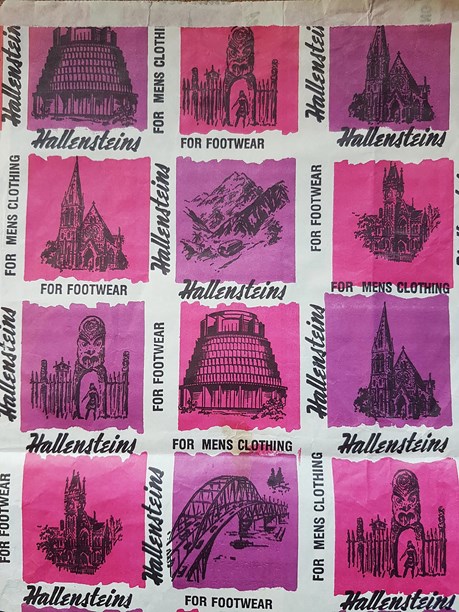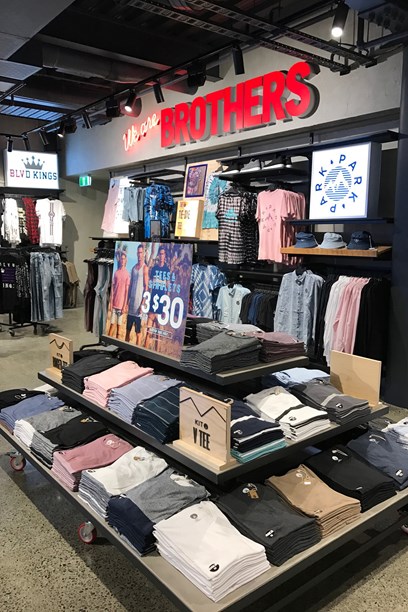Stories
Hallensteins
1873-

One of the most enduring brands in the New Zealand clothing industry had its origins with the arrival here of the impressively named Bendix Hallenstein. He was born in 1835 in Germany, where his parents owned a mill producing woollen cloth from rags. The young Bendix travelled to Manchester, and in 1857, along with brothers Isaac and Michaelis, followed a well-worn path to the goldfields of Victoria, Australia.
But the Hallenstein brothers were more interested selling goods to miners than in gold panning. Their name first appeared in New Zealand in 1863 when Melbourne wine and spirit merchants and general importers Buttner and Hallenstein, after nine years in Victoria, decided to extend their business to the southern regions of New Zealand. In addition to a range of alcoholic beverages that included champagne and absinthe, the company offered staple foodstuffs, pills and ointments, and large selection of equipment and clothing for miners. By mid-1863 the new branch of Buttner and Hallenstein was operating in Dee Street, Invercargill, with the wholesale department managed by Bendix Hallenstein.

Bendix Hallenstein founded the Hallensteins business with his brothers in 1873. Image courtesy of Toitū Otago Settlers Museum.
Business grew, and Bendix Hallenstein soon established general stores elsewhere in the region, in Arrowtown, Cromwell and Lawrence. From 1869 to 1872 he also mayor of Queenstown, winning the election by what was described as 'virtually a walkover' with 132 votes to the other candidate’s 24. The decision to elect Hallenstein was considered 'a wise one', and hardly surprising in view of his business interests in Queenstown and the Lakes District generally. In addition, Hallenstein served as Member of the House of Representatives for Wakatipu in 1872-3.
In 1873, prompted by the difficulty of sourcing men’s clothing for his stores, Bendix Hallenstein and his brothers established the New Zealand Clothing Factory in Dunedin. By the following year the business had moved into new three-storey premises in Rattray Street, with a large general work-room housing 14 sewing machines, plus binding and button-hole machines - both by Singer, and said to be the only two of the kind in the colonies. At this stage there were 60 employees, working from 8.30am-5.30pm on weekdays, with an hour for 'dinner', and until 2pm on Saturdays.
By 1875 Hallenstein’s factory was producing a large amount of stock and in a canny business move Bendix sold the property to the National Insurance Company, subsequently renting it back. With his capital freed up, he was able to begin buying his own shops. The first opened in 1876, in the Octagon, Dunedin, and others soon followed in Christchurch, Timaru, Wellington and Oamaru. Further stores were then opened in Auckland, Napier, Ashburton, Whanganui, Invercargill, Nelson, New Plymouth and Thames, and by 1900 there were 34 Hallenstein shops around the country.

The Hallenstein Brothers New Zealand Clothing Factory store in Queen Street, 1903. Image from Auckland Weekly News 12 November 1903, courtesy of Sir George Grey Special Collections, Auckland Libraries, AWNS-19031112-15-1.
Auckland architect Edward Mahoney designed several buildings for Hallensteins, including, in 1912, three-storey premises at 246-254 Karangahape Road, which were extended in 1926.
By 1905 the New Zealand Clothing Factory could claim that 'All needful precautions for the prevention of accidents had been anticipated, and every convenience required for the health and comfort of the large body of employees – mostly women and girls – had been supplied.' The company now employed upwards of 300 staff, operating some 80 machines, most of which could produce 1800-2300 stitches per minute, while some 1800-2500 garments were completed each week.
In 1884 the indefatigable Bendix Hallenstein had also founded the Drapery and General Importing Company retail chain (later known as the DIC) in Dunedin. This business grew rapidly, stocking a wide range of clothing and mercery, along with household goods and furniture, while the Dunedin showrooms also offered customers a refreshment room and well-let dressing and fitting rooms. In 1891 the DIC opened a store in Wellington, soon followed by others in Lower Hutt, Whanganui and Invercargill, and eventually there were 13 stores around the country. In the 1980s the DIC chain disappeared when it was taken over by one of its main rivals, Arthur Barnett.
Bendix Hallenstein died in 1905, aged about 70. He was noted for his concern for the working conditions of his staff, and also for his generosity, bequeathing £500 towards the building of a new ward at the Dunedin Hospital.
In 1906, the year after his death, the firm of Hallenstein Bros. and Co. became a limited company, now operating as Hallenstein Bros. (Ltd.) Of the three original Hallenstein brothers, Michaelis had died in London in 1904, and the last to survive, Isaac, died in Germany in 1911.

A Hallensteins window display advertising 'Tones of Taste' and 'Correct styling', Autumn 1930. Photo by Reginald Silvester Lediard, courtesy of Auckland War Memorial Museum, PH-NEG-C25637.
By the 1980s Hallenstein Bros. had become the country’s largest specialists in clothing for men and boys, opening its 58th store on Wellington’s Lambton Quay in 1980 and reaching 72 outlets in 1986.

Hallenstein's bag, circa 1973. Image courtesy of Hayley Smith.
The following year it merged with Glassons, to become part of New Zealand’s largest clothing company.
Like Bendix Hallenstein, John Hooper Glasson had come to New Zealand from Melbourne (where he was born in 1858). He settled in Timaru, and in 1900 moved to Christchurch where he established the clothing business of Glassons Ltd in 1918. Based in Cashel Street, the company advertised its garment-making services around the South Island, with a choice of over 50 patterns. In 1919 it offered a six-months’ wear guarantee on a pair of wool saddle tweed trousers, and three years later it established a branch in Nelson. Today, there are 38 Glassons stores throughout New Zealand, plus another 28 in Australia.
In the 1990s the Hallenstein chain was repositioned, moving away from the traditional association with singlets, pyjamas and flannelette shirts to embrace hoodies, sweatshirts, chinos and joggers, as well as suits and business shirts.

A Hallensteins Brothers store in Christchurch. Image © Hallensteins.
Today there are 42 Hallenstein Bros. stores in New Zealand and another three across in Queensland, Australia.
Text by Richard Wolfe.
Last published May 2017.